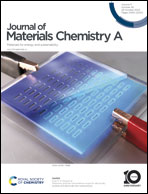Towards an atomic scale understanding of the early-stage deterioration mechanism of LSCF†
Abstract
The early-stage degradation behaviour of a porous lanthanum strontium cobalt ferrite (LSCF) cathode in a solid oxide fuel cell is investigated at a low temperature of 600 °C by operating four cells under different conditions: in dry air and at open circuit voltage (Dry-OCV), in dry air and under bias (Dry-bias), in wet air and at OCV (Wet-OCV), and in wet air and under bias (Wet-bias). Compared with Dry-OCV, either H2O or bias shows a negative effect on the electrochemical and transport characteristics, resulting in the most severe degradation in Wet-bias. The mechanism is explained in terms of LSCF deterioration, which is intensively studied on a micro- to atomic scale. No surface segregation is observed in the as-prepared cathode; however, sulfur is found to be incorporated into the lattice of the LSCF(110) surface. After operation, nano-segregation occurs in all the cathodes. SrSO4 particles form in all the cathodes while Sr(OH)2 flakes precipitate under wet conditions. The size and distribution of segregations vary with the conditions. For example, some of the SrSO4 particles in Dry-bias grow into bar-like ones (up to 280 nm) compared with smaller ones (36 nm) in Dry-OCV indicating that the kinetics of Sr diffusion and O vacancy formation is accelerated by bias. Their distribution is limited in the cathode surface layer (CSL) in Dry-OCV, Dry-bias and Wet-OCV, while it extends to the cathode/electrolyte interface in Wet-bias, which is caused by the decrease of SO2 adsorption/dissociation kinetics in the CSL in the presence of competitive H2O species (for SrSO4) and the enhancement of H2O mass transport driven by the O2 concentration gradient under bias (for Sr(OH)2). With the formation of segregation, other deteriorations such as sulfur incorporation into the surface, Sr-deficiency in the subsurface, and La–Co-rich regions near the surface occur and evolve in LSCF grains. All these changes lead to the deactivation of the surface O exchange, which is believed to be the dominant reason for the performance degradation.



 Please wait while we load your content...
Please wait while we load your content...